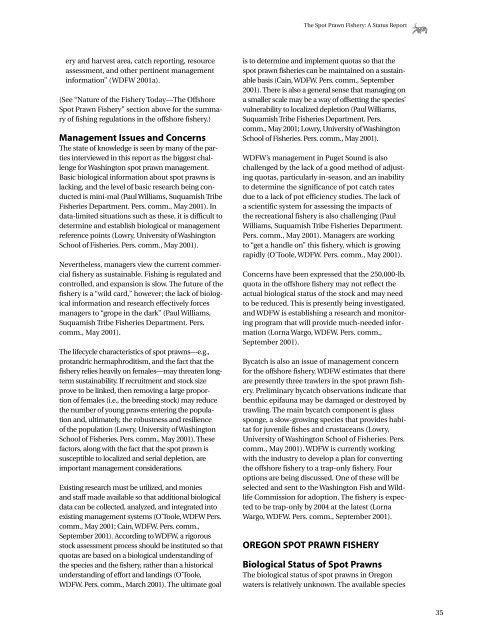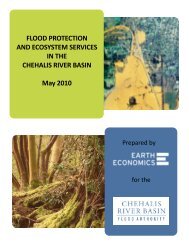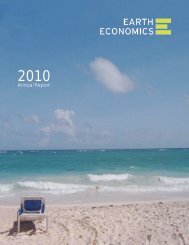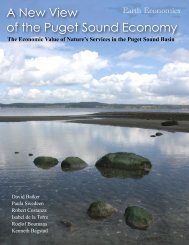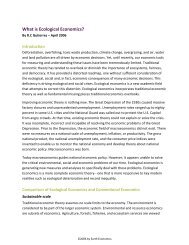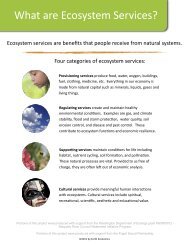The Spot Prawn Fishery: A Status Report - Earth Economics
The Spot Prawn Fishery: A Status Report - Earth Economics
The Spot Prawn Fishery: A Status Report - Earth Economics
You also want an ePaper? Increase the reach of your titles
YUMPU automatically turns print PDFs into web optimized ePapers that Google loves.
<strong>The</strong> <strong>Spot</strong> <strong>Prawn</strong> <strong>Fishery</strong>: A <strong>Status</strong> <strong>Report</strong><br />
ery and harvest area, catch reporting, resource<br />
assessment, and other pertinent management<br />
information” (WDFW 2001a).<br />
(See “Nature of the <strong>Fishery</strong> Today—<strong>The</strong> Offshore<br />
<strong>Spot</strong> <strong>Prawn</strong> <strong>Fishery</strong>” section above for the summary<br />
of fishing regulations in the offshore fishery.)<br />
Management Issues and Concerns<br />
<strong>The</strong> state of knowledge is seen by many of the parties<br />
interviewed in this report as the biggest challenge<br />
for Washington spot prawn management.<br />
Basic biological information about spot prawns is<br />
lacking, and the level of basic research being conducted<br />
is mini-mal (Paul Williams, Suquamish Tribe<br />
Fisheries Department. Pers. comm., May 2001). In<br />
data-limited situations such as these, it is difficult to<br />
determine and establish biological or management<br />
reference points (Lowry, University of Washington<br />
School of Fisheries. Pers. comm., May 2001).<br />
Nevertheless, managers view the current commercial<br />
fishery as sustainable. Fishing is regulated and<br />
controlled, and expansion is slow. <strong>The</strong> future of the<br />
fishery is a “wild card,” however; the lack of biological<br />
information and research effectively forces<br />
managers to “grope in the dark” (Paul Williams,<br />
Suquamish Tribe Fisheries Department. Pers.<br />
comm., May 2001).<br />
<strong>The</strong> lifecycle characteristics of spot prawns—e.g.,<br />
protandric hermaphroditism, and the fact that the<br />
fishery relies heavily on females—may threaten longterm<br />
sustainability. If recruitment and stock size<br />
prove to be linked, then removing a large proportion<br />
of females (i.e., the breeding stock) may reduce<br />
the number of young prawns entering the population<br />
and, ultimately, the robustness and resilience<br />
of the population (Lowry, University of Washington<br />
School of Fisheries. Pers. comm., May 2001). <strong>The</strong>se<br />
factors, along with the fact that the spot prawn is<br />
susceptible to localized and serial depletion, are<br />
important management considerations.<br />
Existing research must be utilized, and monies<br />
and staff made available so that additional biological<br />
data can be collected, analyzed, and integrated into<br />
existing management systems (O’Toole, WDFW Pers.<br />
comm., May 2001; Cain, WDFW. Pers. comm.,<br />
September 2001). According to WDFW, a rigorous<br />
stock assessment process should be instituted so that<br />
quotas are based on a biological understanding of<br />
the species and the fishery, rather than a historical<br />
understanding of effort and landings (O’Toole,<br />
WDFW. Pers. comm., March 2001). <strong>The</strong> ultimate goal<br />
is to determine and implement quotas so that the<br />
spot prawn fisheries can be maintained on a sustainable<br />
basis (Cain, WDFW. Pers. comm., September<br />
2001). <strong>The</strong>re is also a general sense that managing on<br />
a smaller scale may be a way of offsetting the species’<br />
vulnerability to localized depletion (Paul Williams,<br />
Suquamish Tribe Fisheries Department. Pers.<br />
comm., May 2001; Lowry, University of Washington<br />
School of Fisheries. Pers. comm., May 2001).<br />
WDFW’s management in Puget Sound is also<br />
challenged by the lack of a good method of adjusting<br />
quotas, particularly in-season, and an inability<br />
to determine the significance of pot catch rates<br />
due to a lack of pot efficiency studies. <strong>The</strong> lack of<br />
a scientific system for assessing the impacts of<br />
the recreational fishery is also challenging (Paul<br />
Williams, Suquamish Tribe Fisheries Department.<br />
Pers. comm., May 2001). Managers are working<br />
to “get a handle on” this fishery, which is growing<br />
rapidly (O’Toole, WDFW. Pers. comm., May 2001).<br />
Concerns have been expressed that the 250,000-lb.<br />
quota in the offshore fishery may not reflect the<br />
actual biological status of the stock and may need<br />
to be reduced. This is presently being investigated,<br />
and WDFW is establishing a research and monitoring<br />
program that will provide much-needed information<br />
(Lorna Wargo, WDFW. Pers. comm.,<br />
September 2001).<br />
Bycatch is also an issue of management concern<br />
for the offshore fishery. WDFW estimates that there<br />
are presently three trawlers in the spot prawn fishery.<br />
Preliminary bycatch observations indicate that<br />
benthic epifauna may be damaged or destroyed by<br />
trawling. <strong>The</strong> main bycatch component is glass<br />
sponge, a slow-growing species that provides habitat<br />
for juvenile fishes and crustaceans (Lowry,<br />
University of Washington School of Fisheries. Pers.<br />
comm., May 2001). WDFW is currently working<br />
with the industry to develop a plan for converting<br />
the offshore fishery to a trap-only fishery. Four<br />
options are being discussed. One of these will be<br />
selected and sent to the Washington Fish and Wildlife<br />
Commission for adoption. <strong>The</strong> fishery is expected<br />
to be trap-only by 2004 at the latest (Lorna<br />
Wargo, WDFW. Pers. comm., September 2001).<br />
OREGON SPOT PRAWN FISHERY<br />
Biological <strong>Status</strong> of <strong>Spot</strong> <strong>Prawn</strong>s<br />
<strong>The</strong> biological status of spot prawns in Oregon<br />
waters is relatively unknown. <strong>The</strong> available species<br />
35


